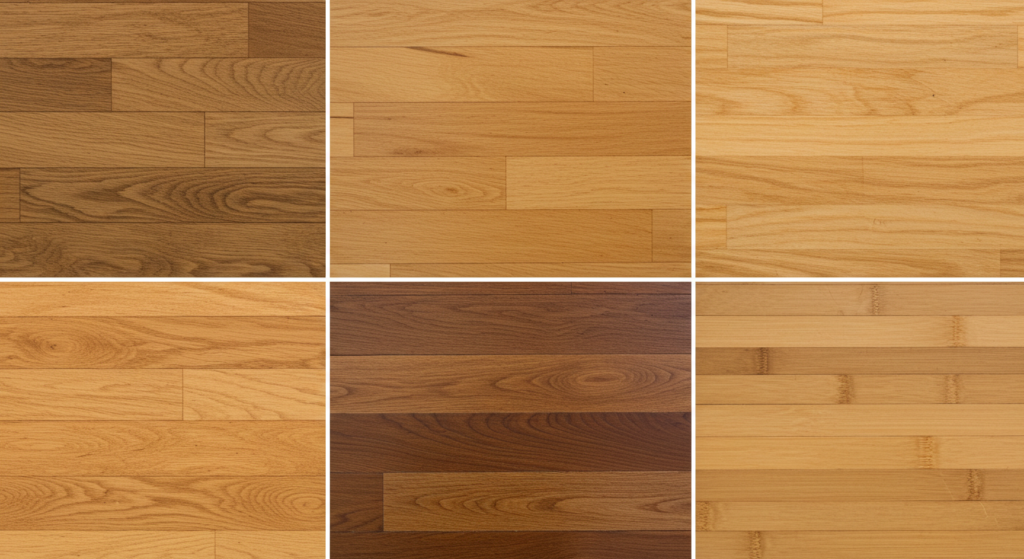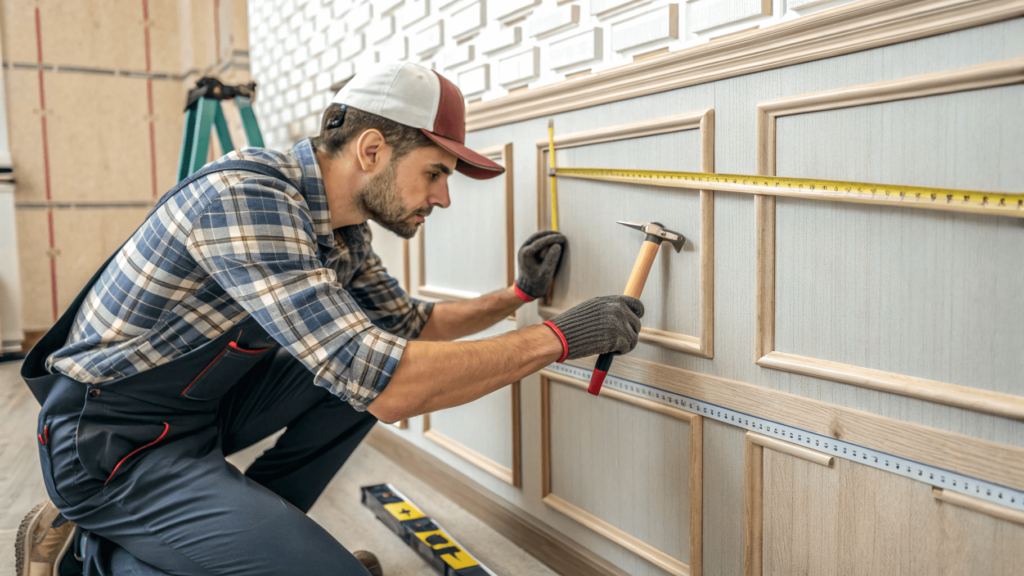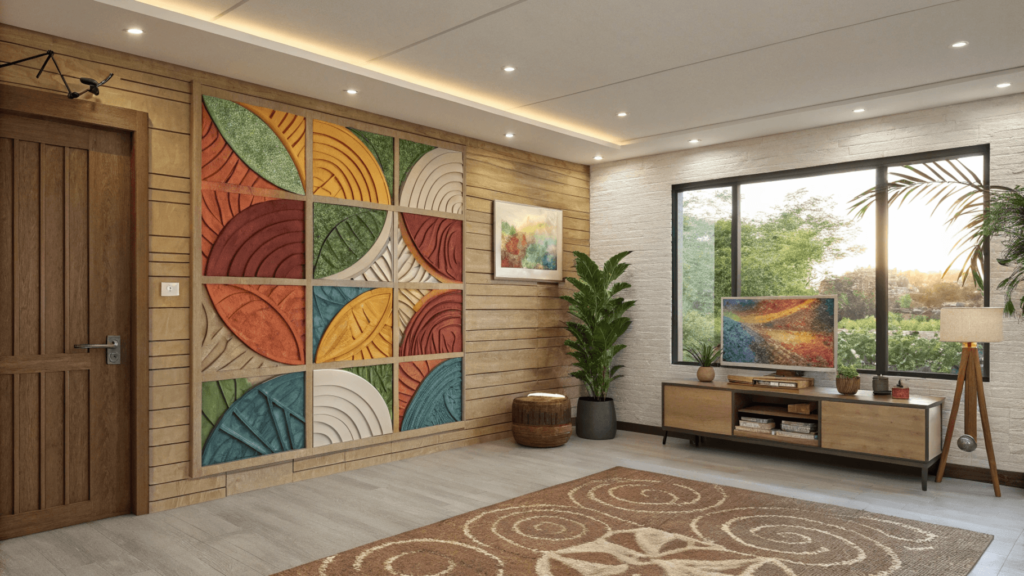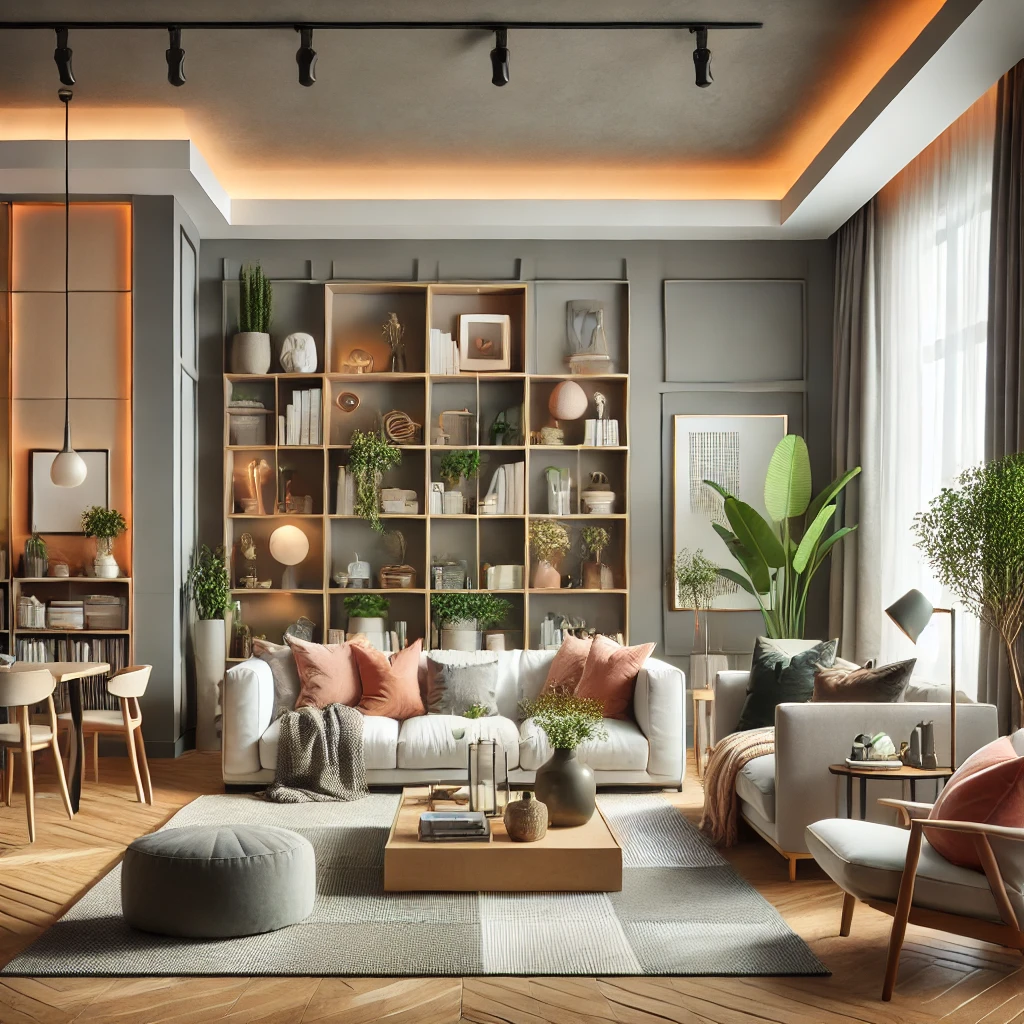Introduction: Where Design Meets Personality
Imagine stepping into a room that doesn’t just whisper, but shouts your style – that’s the transformative power of decorative wall paneling. In 2025, wall panels are more than just a design element; they are a canvas for personal expression, turning ordinary walls into extraordinary storytellers. This is the year your walls get a serious glow-up.
What Are Decorative Wall Panels? Decoding the Design Revolution
Decorative wall panels are the rockstars of interior design – versatile, stunning, and capable of transforming any space from “meh” to “magnificent” in minutes. These aren’t your grandmother’s wallpapers; they are sophisticated, three-dimensional surfaces that add texture, depth, and personality to your living spaces. They range from classic wood styles to modern geometric and tactile designs.
A Deep Dive into Wall Paneling Materials
The world of wall panels offers a diverse array of materials, each with unique characteristics, aesthetics, and uses. Let’s explore the most common options:

- Specific Wood Types:
- Oak: Known for its durability and classic look. Comes in red and white oak, with different grains and color tones. Often used in traditional and modern homes for a timeless feel.
- Maple: A light-colored hardwood with a smooth, uniform grain. Good for contemporary designs and creating a bright, airy look.
- Pine: A softer, more affordable wood with a rustic feel. Can be easily stained or painted, giving a warm, cozy look.
- Walnut: A dark, rich hardwood with a luxurious look. Ideal for creating a statement piece and adding elegance to a space.
- Bamboo: A sustainable, eco-friendly material, known for its rapid growth. It’s durable and has a unique grain pattern, perfect for modern and environmentally conscious designs.
- MDF (Medium-Density Fiberboard):
- Pros: Affordable, smooth surface, easy to paint, versatile designs.
- Cons: Not water-resistant, prone to moisture damage, can warp.
- Uses: Best for areas with low moisture like living rooms and bedrooms. Ideal for creating a clean, modern look, but avoid in bathrooms or areas with high humidity.
- Plywood
- Pros: Lightweight, relatively strong and durable
- Cons: Lower quality sheets may not look good, and not as water resistant as other types of materials.
- Uses: Great for walls, but can be used for other construction.
- PVC (Polyvinyl Chloride):
- Pros: Water-resistant, easy to clean, lightweight, affordable, versatile designs.
- Cons: Can look plastic, not as durable as wood, can fade in sunlight.
- Uses: Ideal for bathrooms, kitchens, or high-traffic areas that need to be easily cleaned, providing both functionality and style.
- Fabric Panels:
- Types: Upholstered panels, stretched fabric panels, sound-absorbing panels.
- Pros: Adds warmth and texture, provides sound insulation, luxurious.
- Cons: Can stain easily, not suitable for high-moisture areas, may require professional cleaning.
- Materials: Linen (natural, durable), Velvet (soft, luxurious), Microfiber (easy to clean, durable) and more. The composition of the fabric will affect the way that the fabric behaves.
- Metal Panels:
- Types: Aluminum (lightweight, rust-resistant), steel (strong, durable), copper (unique, can patina over time), brass (warm, luxurious).
- Pros: Modern, durable, fire-resistant, can be used to create unique designs. Adds a touch of industrial elegance.
- Cons: Can be expensive, may require professional installation, can get damaged by scratching, and can be cold to the touch.
- Uses: Ideal for contemporary and industrial designs, adding a modern and sleek look.
- Cork Panels:
- Pros: Sustainable, sound-absorbing, good thermal insulator, unique texture. Eco-friendly choice.
- Cons: Less durable than other materials, can be hard to clean, may not be suitable for high-traffic areas.
- Uses: Good for home offices, living rooms, or bedrooms where sound absorption and a natural feel are desired.
- Mirrored Glass Panels
* Pros: Adds depth and spaciousness to the room. Can be combined with other paneling to create dramatic looks, as well as increase light.
* Cons: Can be expensive and difficult to install, very delicate and susceptible to scratching. Can also become dirty easily.
* Uses: Suitable for any room that can use a little more space, as well as living rooms, hallways, etc. - Recycled Materials:
- Examples: Recycled plastic, reclaimed wood, recycled paper, using waste to reduce the environmental impact of production.
- Benefits: Environmentally friendly, unique look, supports sustainable practices, reduces carbon footprint.
Quick Snapshot: Wall Paneling 101
| Panel Type | Texture | Style Vibe | Complexity of Installation |
| Wood Panels | Natural, Warm | Rustic to Modern | Moderate |
| 3D Geometric | Dramatic, Sculptural | Contemporary | Medium Complexity |
| Acoustic Panels | Soft, Functional | Minimalist | Technical |
| Textured Fabric | Luxe, Subtle | Elegant | Professional Install |
Why Wall Paneling? More Than Just a Pretty Face
Let’s get real – wall paneling isn’t just about looking good (though it definitely does). It offers significant benefits:

- Sound Management: Wall panels, especially acoustic panels, are designed to absorb sound waves, reducing echo and noise within a room. Look for panels with a high Sound Transmission Class (STC) rating. For example, some panels can achieve an STC rating of 20 or more, reducing noise transfer by a measurable amount. The specific material and thickness of the panel will greatly influence its effectiveness.
- Insulation Boost: Certain wall panels, particularly those made from wood or with an insulating core, can add a layer of thermal insulation to your walls. This can help to reduce energy costs by keeping the room warmer in the winter and cooler in the summer. In some cases, you might save 5% to 15% on your heating and cooling bills, depending on the type and R-value of the panel you choose.
- Instant Room Transformation: Wall paneling offers a way to drastically change the aesthetic of a room with less hassle than a full renovation.
- Covering Imperfections: Wall panels are great for concealing imperfections such as dents, cracks, and uneven surfaces. They can bring a new look to an old room without the need for a complete renovation.
“Wall panels are like the superhero cape for your interior design – they rescue boring spaces and make them extraordinary.” – Your Design Bestie (aka me)
2025 Trending Wall Paneling Styles: What’s Hot Right Now
1. Sustainable Chic
Eco-conscious design is here to stay. Reclaimed wood panels, often sourced from old barns, factories, and other structures, are gaining popularity due to their unique character and eco-friendly appeal. Look for Forest Stewardship Council (FSC) certified materials for sustainable sourcing, and consider panels that use non-toxic adhesives and finishes. These panels often tell a story with their unique textures and history.
2. Minimalist Geometry
Clean lines and geometric patterns are going to be everywhere in 2025. Expect to see panels with repeating shapes like squares, triangles, hexagons, and chevrons in subtle colors. These panels are perfect for adding a sense of modernity without being overly distracting and are versatile enough to complement a variety of design themes.
3. Textural Storytelling
The trend towards tactile surfaces continues to grow. Expect to see 3D wave-like designs, organic curves, and panels made from materials such as textured concrete or resin, which change with the light. These panels add a layer of depth and visual interest that will encourage people to engage with your walls and create a more dynamic interior.
The Cost Breakdown: What’s Your Budget Saying?
Wall paneling is an investment with varying price points. The cost depends on the material, design, and complexity:
- Budget-Friendly: $5 – $15 per square foot.
- Material Examples: Basic MDF or PVC panels with simple patterns and finishes.
- Designs: Simple beadboard, plain flat panels, basic colors. These options are ideal for smaller spaces or for those who are looking for a simple and cost-effective way to add a new look to the walls.
- Mid-Range Magic: $15 – $35 per square foot.
- Material Examples: Solid wood (pine, basic maple), better quality textured or printed designs, thicker panels.
- Designs: More elaborate geometric patterns, textured designs with details, and more complex styles. This range often offers a good balance between quality and cost, allowing for a higher quality and more elaborate design without breaking the bank.
- Luxury League: $35 – $100+ per square foot.
- Material Examples: High-quality hardwoods (walnut, oak), unique metal panels, custom-made designs, premium acoustic panels, fabric panels with silk or linen.
- Designs: Intricate 3D patterns, custom finishes, panels with built-in lighting, and other very specialized designs. These options are for those who want the highest quality materials and are looking to add luxurious and specialized look to their home or office.
Factors Affecting Price: The final price tag is affected by material, complexity of design, custom elements, size of the order, labor costs, prep costs, disposal costs, and other hidden costs.
Maintenance: Keeping Your Panels Pristine
Maintaining wall panels is straightforward, but the method will depend on the materials:
- Wood Panels:
- Use specific wood cleaners for cleaning.
- Use a soft cloth to avoid scratches.
- Avoid using harsh chemicals.
- For scratches, use a wood repair pen or filler.
- Fabric Panels:
- Use a soft brush or vacuum to remove dust.
- For stains, blot with a clean cloth and use a fabric cleaner.
- Professional cleaning is recommended for tougher stains.
- PVC Panels:
- Use a mild soap and water solution for regular cleaning.
- Avoid abrasive cleaning tools or chemicals that can damage the surface.
- Metal Panels:
- Use specific metal cleaning products to avoid corrosion.
- Use a soft cloth to prevent scratching.
* Mirrored Panels: - Use a glass cleaner and microfiber cloth to avoid streaks.
- Avoid harsh chemicals.
Installation: DIY or Professional?
Some panels are DIY friendly, while others may require the expertise of a professional. Always make sure to do your research and ensure that you are able to carry out a DIY installation safely.
DIY Difficulty Scale
- Wood Panels: ⭐⭐ (Moderate).
* Requires careful cutting, measuring, and proper fastening.
* Tools & Materials:
* Stud finder, level, measuring tape, pencil.
* Miter saw or circular saw with a fine-tooth blade.
* Nail gun or screws (with appropriate drill bits), construction adhesive.
* Safety glasses and gloves.
* Spacers for consistent gaps.
* Steps:
1. Preparation: Locate studs and mark them on the wall. Ensure the walls are clean and dry.
2. Measure and Plan: Calculate the number of panels needed and plan the layout.
3. Cutting: Measure and cut panels with a miter or circular saw.
4. Adhesive: Apply construction adhesive to the back of each panel.
5. Fastening: Align the first panel and press it against the wall, using spacers for gaps. Secure with nails or screws at the marked stud locations.
6. Continue: Install the remaining panels, ensuring proper alignment and spacing.
7. Finishing: Fill nail holes or joints with wood filler and sand smooth. Apply caulk where needed, and paint or stain as desired. - 3D Panels: ⭐⭐⭐⭐ (Advanced)
* Requires advanced skills due to intricate designs and precise measurements for seamless installation.
* Tools & Materials:
* Stud finder, level, measuring tape, pencil.
* Miter saw or circular saw with a fine-tooth blade.
* Construction adhesive, spacers.
* Safety glasses and gloves.
* Steps: The steps are similar to wood panels, but due to the design, require more precision to align the pieces correctly and avoid gaps. - Fabric Panels: ⭐ (Beginner-Friendly)
* Some panels can be applied with adhesive or hook and loop fasteners.
* Tools & Materials:
* Some require only adhesive, others require screws and a screw gun, depending on the manufacturer.
* A level.
* Measuring tape and a pencil.
* Safety glasses and gloves.
* Steps: Depending on the design and manufacturer, some panels can be attached using adhesives directly to the wall. Others require a frame or backing that attaches to the wall, and then the panel is attached to the frame.
Professional Installation: If you’re not comfortable with DIY, seek out a reputable installer. They will have the right tools and knowledge for seamless installation.
“How to Choose a Professional Installer“
- Research and Vetting:
- Ask for references and look at reviews from other clients.
- Check their portfolio of previous projects.
- Certifications:
- Are there any certifications that they should have?
- Experience:
- How much experience do they have with wall paneling projects?
- Insurance and Licensing:
- Do they have the necessary insurance and licenses?
- Detailed Quotes:
- Request a detailed quote to compare different installers
- Warranty:
- Do they offer any warranty on their work?
- Questions to Ask:
- “Can you provide a written quote?”
- “How long will the project take?”
- “Do you have insurance?”
- “Can you give me a list of references?”
Styling Ideas and Visual Examples
Here are some examples of how to use wall paneling in different rooms.
- Living Room:
- Focal Point: Use a feature wall with unique paneling to highlight a fireplace or TV wall.
- Color Coordination: Choose a panel color that complements furniture or rugs.
- Texture: Create a warm atmosphere with textured wooden panels or a stylish look with metal panels.
- Bedroom:
- Headboard Alternative: Use upholstered or decorative panels to create a stylish headboard.
- Relaxing Ambiance: Choose soft colors and natural materials such as fabric panels.
- Sound Control: Acoustic panels can make the bedroom quieter and more calming.
- Home Office:
- Professional Look: Opt for sleek geometric patterns or wood tones for a professional feel.
- Sound Absorption: Install acoustic panels to minimize distractions.
- Bathroom:
- Moisture Resistance: Choose PVC or other water-resistant materials.
- Easy Cleaning: Consider panels that are easy to wipe down, and avoid fabric panels.
- Visual Interest: Add panels with subtle patterns.
- Hallways/Entryways:
- Create Welcoming Areas: Use wall paneling to create an interesting entryway.
- Add Depth: Mirrored panels can add depth, light, and visual interest to your hallways or entryways.

Legal Considerations
- When purchasing materials for wall paneling, you should adhere to the following:
- Forest Stewardship Council (FSC) certification: This certification ensures that wood products come from responsibly managed forests.
- Health and safety standards: The materials must meet the required safety standards and not include any toxic materials.
- Building codes: The materials must meet local building codes.
- Import/export regulations: There may be regulations for the import or export of certain materials.
Final Thoughts: Your Walls, Your Canvas
Decorative wall paneling in 2025 is more than a trend but a powerful means of expressing yourself and creating unique spaces. It’s about using your walls to showcase your style and preferences.
Ready to Panel Up?
Don’t just dream it. Do it. Transform those walls from “blah” to “BOOM!”
Verified Resources:
- Aenzay Homes
- Urban Galleria Home Decor Collection
- Amazon Home Decor
- Wood Action Decor
- Habitt Decor Collection
- Interwood Decor
- Alfa Decor
- Dictionary Definition of Decor
Disclaimer: Prices and trends are approximate. Always consult with a design professional for personalized advice.



